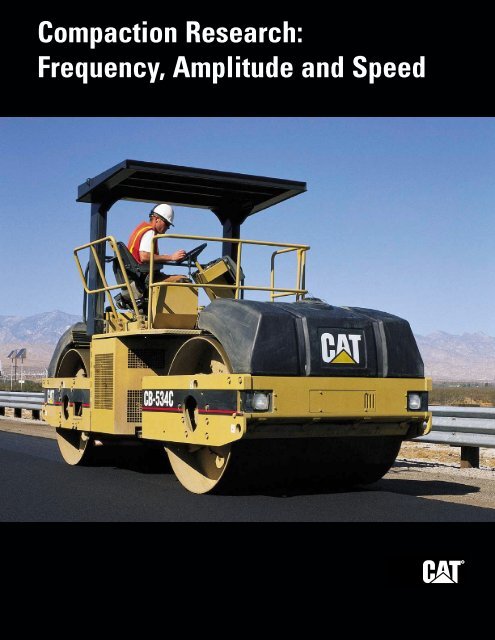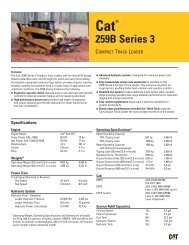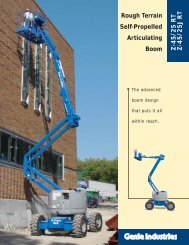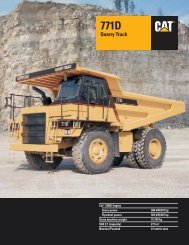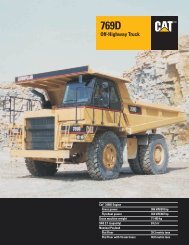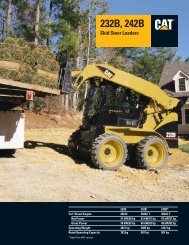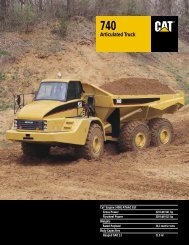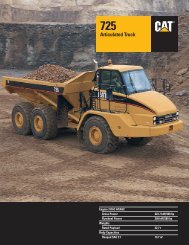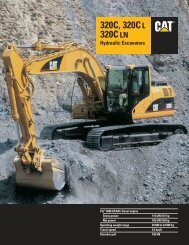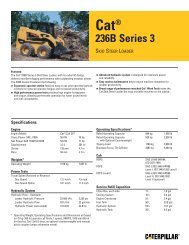Compaction Research: Frequency, Amplitude and Speed QEDQ9874
Compaction Research: Frequency, Amplitude and Speed QEDQ9874
Compaction Research: Frequency, Amplitude and Speed QEDQ9874
You also want an ePaper? Increase the reach of your titles
YUMPU automatically turns print PDFs into web optimized ePapers that Google loves.
<strong>Compaction</strong> <strong>Research</strong>:<strong>Frequency</strong>, <strong>Amplitude</strong> <strong>and</strong> <strong>Speed</strong>R
The reason that high frequency must be matchedto low amplitude is the need for acceptablebearing life. No one wants to replace vibratoryweight shaft bearings once or twice a year;bearing life must be three to five years, or maybeeven up to ten years. A typical equation used toestimate bearing life shows the factors that affectvibratory bearing life.The lube factor term shows that, if the bearing islubricated well, it will have a longer life. If it islubricated poorly, it will have a shorter life.Load rating is the bearing manufacturer’smaximum load rating. Centrifugal force is theactual centrifugal force to which the bearing issubjected. A small increase in centrifugal forcecauses a large reduction in bearing life.The speed factor is the speed at which the bearingis spinning. If the vibratory frequency goes up,then bearing speed increases, <strong>and</strong> the bearing lifegoes down.Increasing the vibratory frequency has the biggesteffect on the bearing. Higher frequency produceshigher loads, higher temperature <strong>and</strong> more loadcycles. Vibratory system design must be changedsignificantly if high frequency is used.Now let’s see how frequency <strong>and</strong> working speedare related.In the first example, the compactor has a frequencyof 2500 vibrations per minute (vpm) <strong>and</strong> a targetfor impact spacing of 10 impacts per foot (ipf).The working speed will be about 250 feet perminute (fpm) to achieve the target of 10 ipf.In the second <strong>and</strong> third examples, the compactorhas a frequency of 3800 vpm. One way to operatethe machine is to keep the same speed, 250 fpm,<strong>and</strong> get more impacts per foot. So, at the sameworking speed, the drum hits the mat more oftenusing a higher frequency, but it will normally havea lower amplitude.Or,the machine can operate faster, up to 380 fpm,<strong>and</strong> get 10 impacts per foot, again at a loweramplitude.It’s obvious that there are many possiblecombinations of amplitude, frequency <strong>and</strong> workingspeed. Let’s try to classify which combinationswork better on which compaction applications.3
One on-the-job research project took place on I-10in Arizona. The project involved a variety of liftthicknesses <strong>and</strong> mix designs. It provided the opportunityto experiment with different amplitudes <strong>and</strong>frequencies. The primary research objective dealtwith the effects of varying amplitude.The mix that was used was a fairly typical coarsegradedSuperpave design with fully crushedaggregate. The nominal aggregate size was 25 mm(1'') in the binder course <strong>and</strong> 19 mm (3/4'') in thesurface course.The binder course thickness was 125 mm (5'') forone lane <strong>and</strong> 75 mm (3'') for the other lane.Corresponding ratios of lift thickness to aggregatesize were 5:1 <strong>and</strong> 3:1. The surface coursethickness was 75 mm (3''), so the ratio of liftthickness to aggregate size was 4:1.It was expected that high amplitude would beneeded to achieve density in this application.4
Based on the expected need for high amplitude, aspecial research compactor, utilizing very highamplitude, was given to the contractor. Theresearch unit delivered higher force <strong>and</strong> moreamplitude than any commercially availablevibratory compactor.The extra compaction energy was noticeable toeveryone st<strong>and</strong>ing close to the machine.On this project, the conclusion was the higher theamplitude the better for thick lifts. Even workingon the 75 mm (3'') lift, they got better productivity<strong>and</strong> density out of higher amplitude operation.To further examine the affects of differentamplitude settings, controlled testing was set up.The goal was to do side-by-side testing withdifferent machines working on different layerthicknesses.More than 100 measurements were taken duringthis round of testing.5
Testing was done on five different layers. Therewere four layer thicknesses, ranging from 100 mm(4'') down to 25 mm (1''). Two mix designs withdifferent aggregate sizes were used.One of the most important factors to considerwhen trying to underst<strong>and</strong> compaction issues isthe thickness to aggregate size ratio. In this case,we tested this ratio from about 5:1 all the waydown to 2:1.When the ratio is high, like 5:1, it is usuallypossible to use high force associated with highamplitude <strong>and</strong> not be too concerned aboutdamaging aggregates. When the ratio is low, like2:1, normally high amplitude is not usable.Thinner lifts with lower thickness to aggregatesize ratios are very challenging, often almostuncompactable.The controlled compaction testing was done in aCaterpillar Dealer’s yard. A parking lot, severallayers thick, was constructed. Each layer includedseveral test “cells”, each cell with a different set ofcontrolled test conditions.The markings on the mat indicate where nucleardensity measurements were made. Each one ofthese indicates a different test cell.The site was constructed using a high traffic volumehighway mix even though it was a parking lot.6
The test was devised to simulate highway pavingconditions.The trucks delivered only enough material to buildone or two cells at a time. The mix temperature<strong>and</strong> laydown procedures were the same for eachtest cell to minimize the variables that affectdensity.As each test cell was paved, the compactorsoperated side-by-side to the same position behindthe paver. The compactors were timed so they wereoperating just as they would on a highway job.This bar chart shows the results of all amplitudetesting. The tested amplitudes, expressed in inches,are shown on the bottom <strong>and</strong> range from the loweston the left end of the chart up to the highestamplitude on the right end. The bars show theaverage density <strong>and</strong> maximum density reading,expressed in pounds per cubic foot (pcf), for eachamplitude.The unmistakable trend in this chart is higherdensities result from higher amplitudes. Whetherlooking at average density for each amplitude ormaximum density achieved by any machine at agiven amplitude, the general result is the same.Density increases with amplitude.7
The next on-the-job research project was one thatfocused on the affects of different vibratoryfrequencies. This project involved re-paving a veryheavily traveled section of I-94 between Chicago<strong>and</strong> Milwaukee.On this project, the asphalt layers were muchthinner than what were studied during the Arizonaproject. The leveling course was 38 mm (1 1/2'').The surface course was only 19 mm (3/4'') thick.Consequently, the surface course was a thin stifflayer with a low thickness to aggregate size ratio.High amplitude definitely could not be used onthis project <strong>and</strong> it was expected that compactionwould be difficult to achieve.Paving the thin lift at a width of 4.6 m (15'), thecontractor wanted to pave fairly fast. Thecompactors available for the project had 1.7 m(5 1/2') wide drums. To keep up with the paver, therollers needed to work fast, but still needed toproduce about 10 impacts per foot.8
The contractor found that the combination ofhigher frequency <strong>and</strong> lower amplitude workedwell in this application.Caterpillar provided another research compactorfor this contractor to use. This machine had ahigher frequency than the st<strong>and</strong>ard model <strong>and</strong> awide range of amplitudes.On this project, even the lowest amplitude settingof the research machine was not low enough. Asthe roller started into its second pass, the machinebegan to bounce, or decouple. In other words, themat could not accept all the energy delivered bythe vibrating drum. The density measurementsconfirmed the machine was spending too muchtime bouncing <strong>and</strong> not enough time compacting.To eliminate the problem of decoupling whencompacting the thin mat, it was necessary tocreate a different combination of high frequencywith lower amplitude.Once a new high frequency-low amplitude versionwas developed, Caterpillar did more side-by-sidetesting. In this series of controlled tests, the focuswas on the effects of different frequencies, <strong>and</strong> bothhigh frequency-low amplitude <strong>and</strong> low frequencyhighamplitude models were studied. The objectivewas to determine what conditions were best forhigh frequency operation.9
Four models were tested, resulting in three designfrequencies. The low frequency-high amplitudemachine ran at 2520 vpm. The medium frequencymodel developed 3200 vpm. The high frequency-lowamplitude compactor ran at a frequency of 3800vpm.At least one test was completed for each machineoperating at a speed that developed an impact spacingof 10 impacts per foot.This chart shows a load-up curve for each of thefrequencies tested. This is the kind of curve that anuclear density operator would draw up using themeasurements taken while setting up a rollingpattern. Density, expressed in pounds per cubic foot(pcf), is shown on the left side. The number ofmachine passes is shown across the bottom of thechart.The chart shows all the data taken during the test<strong>and</strong> gives a general or average indication of howdensity changes with frequency. There are manydata points <strong>and</strong> the results are based on a largenumber of tests.The data shows that density goes down withincreased frequency. It doesn’t mean that a givendensity can’t be achieved with a higher frequencyroller – it just may take more passes. For example,if the target density is 140 pcf, it might take about 4passes with a 2520 vpm machine. Using a 3800vpm machine, it might take about 8 passes to reachthe same target density.10
This bar chart shows the results for each of thelayer thicknesses tested, from 25 mm (1'') thick upto 100 mm (4'') thick. For each layer thickness, thebars show the highest density achieved using 2520vpm (L), 3200 vpm (M), <strong>and</strong> 3800 vpm (H)machines.The large arrow shows a revealing general trend;density usually increases with layer thickness. Inother words, thin mats are normally the mostdifficult to compact. This result is easiest to see bylooking at the tops of the low frequency bars (L)bars. Another interesting trend is indicated by therelatively flat line generated by the high frequency(H) bars. Density didn’t change much regardless ofthe lift thickness for the 3800 vpm tests.The smaller arrows show that density generallydecreases with an increase in frequency for eachlayer thickness starting at 50 mm (2''). Compactinga 25 mm (1'')mat, higher frequency produces thesame or slightly higher density. So, thinking aboutan application match for high frequencycompactors, layer thickness is probably limited toabout 50 mm (2'') for high frequency compaction.Let’s look at one more on-the-job researchexample. This project was a large resurfacingproject on the East Coast.In this case, the contractor was trying to compact25 mm (1'') aggregate into a 50 mm (2'') layer.This means the thickness to aggregate size ratiowas 2:1. Based on the low ratio, it was likely to bea difficult compaction project.For a 25 mm (1'') Superpave mix design, there maybe as much as 10% of the material larger than 25mm (1''). Therefore, some of the material being putinto the 50 mm (2'') layer was 38 mm (1 1/2'') insize <strong>and</strong> the layer thickness to aggregate size ratiocould be as low as 1.3:1.11
This turned out to be “one of those projects” witha variety of problems.The contractor was observing an unacceptabledegree of density variation. And, they were havinga difficult time just making it to minimum density.There was tenderness. The tender zone extendedfrom about 250 degrees F all the way to about 140degrees F, making the temperature zone forproductive compaction very small. And, trying tolay down a large stone in a 50 mm (2'') layer, theywere seeing a fair amount of segregation.A lot of experimentation with different compactiontechniques was attempted. They tried severaldifferent machines in different positions. A widerange of amplitude <strong>and</strong> frequency combinationswas tried, too.In the end, nothing worked very well on aconsistent basis. There was no real benefit in highamplitude, low amplitude, high frequency, or lowfrequency.The real problem was that the road design <strong>and</strong> mixdesign made the job of construction, <strong>and</strong>compaction in particular, very difficult. For thisproject, it was not possible to significantly changeeither road or mix design to improve the endresult.There were also some construction methods thatwere preventing good density results. For example,the crew was raking the coarse material at the jointover onto the hot mat. Since this mat was so thin,any raking at all caused significant segregation.This was the main reason they were gettingdensity variations.12In the end, they were able to find a few workingconditions that helped them get to their minimumdensity specifications. Vibrating only one drum onthe breakdown roller helped. Keeping the workingspeed down also helped to keep densities up.
More research was needed to help underst<strong>and</strong> theeffect of working speed on compaction results. Thistime, the controlled test was set up to measure howspeed affects density in different layers.The data were charted on “load-up” curves for thedifferent speeds that were tested. The three speedstested were:1. 250 fpm, getting 10-15 ipf2. 320 fpm, getting 8-12 ipf3. 380 fpm, getting 7-10 ipfThe general result is that density goes down withan increase in travel speed. The results here showthat the 250 fpm <strong>and</strong> 320 fpm tests ended up withabout the same level of density. Density decreasedthe most when working speed was increasedsignificantly up to 380 fpm.13
When the data are arranged in a bar chart, othertrends are noticeable. This time, test results aregrouped by working speed on various liftthicknesses from 25 mm (1'') to 100 mm (4'').The large arrow shows the general increase indensity going from a thin lift to a thick lift. Thistrend matches earlier research (based on variousamplitude <strong>and</strong> frequency settings) that showedhigher densities are achievable in thicker lifts.The small arrows show that regardless of the liftthickness the density generally goes down whencompaction speed goes up. Comparing the lowspeed (L) <strong>and</strong> high speed (H) bars at eachthickness, it is evident that working speed has agreater impact on thicker lifts. It may be that invery thin lifts speed can go up without having abig effect on density. But as layer thicknessincreases, a bigger drop in density is expectedfrom faster working speeds.Based on the results of the on-the-job research <strong>and</strong>the controlled testing, some conclusions can bedrawn about the relationships between amplitude,frequency <strong>and</strong> working speed. It all comes down toa basic question: “What do you want to do?”If the goal is to bring density up, the most reliablemethod is always to use higher amplitude. Higheramplitudes are most effective on lifts greater than50 mm (2'') thick. Because of vibratory systemdesign requirements, higher amplitude isassociated with a lower frequency machine.Also, reducing speed will bring the density up.14
Perhaps increasing density is not the mostimportant goal for a project. Maybe the objectiveis to have the roller travel faster in order to keepup with the paver.In that case, higher frequency may be the bestsolution. <strong>Research</strong> has shown that high frequencyis most effective in layers less than 50 mm (2'')thick. One reason is that higher speed is normallyused <strong>and</strong> that results in lower densities. Anotherreason is that higher frequency is normallyassociated with lower amplitude. A generalreduction in density should be expected whenswitching from a lower frequency to a higherfrequency. Though lower densities may not resultevery time high frequency is used, it is likely tohappen often enough that more passes should befactored into the rolling pattern.Considering the available arrangements of vibratoryasphalt compactors, there are two choices:1. low frequency combined with high amplitude2. high frequency combined with low amplitudeLow frequency-high amplitude models are the mostversatile units, because they offer a wider range ofamplitude settings. They have distinct high <strong>and</strong> lowamplitude settings <strong>and</strong> can be used on thick lifts orthin lifts.High frequency-low amplitude models are specialtymachines, mostly suitable for thin lifts. Even ifhigh frequency compactors have a range ofamplitude settings, all the settings are classed aslow amplitude <strong>and</strong>, therefore, are not productive onthicker lifts of asphalt.15
In conclusion, the research projects <strong>and</strong> controlledtesting proved that the basic theory <strong>and</strong> principlesof asphalt compaction still apply, even withSuperpave mix designs. While it is often necessaryto experiment with equipment <strong>and</strong> methods, goodconstruction practices must be used. Once amethod has been developed that meets densityrequirements on a project, stay with that pattern;control the variables; make adjustments based onexperience <strong>and</strong> training.16
Notes17
Notes18
Notes19
<strong>QEDQ9874</strong> (07/01)© 2001 CaterpillarR


